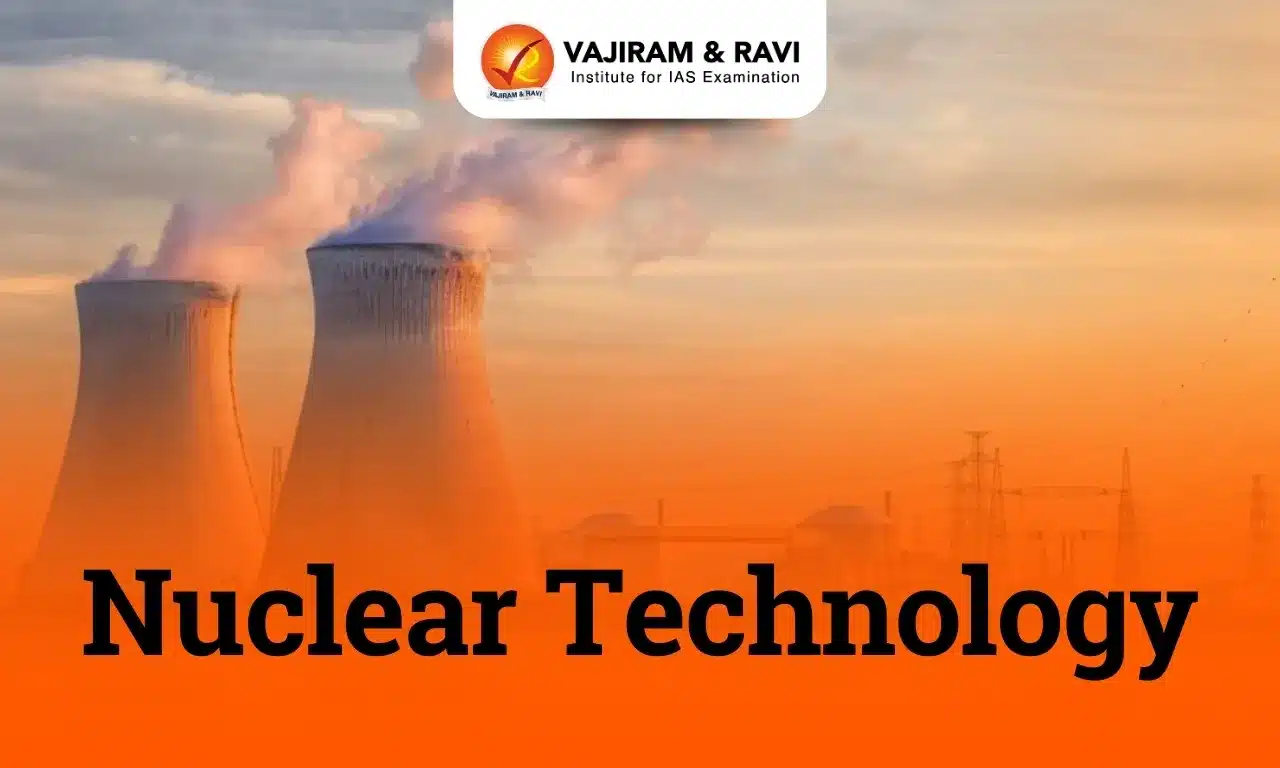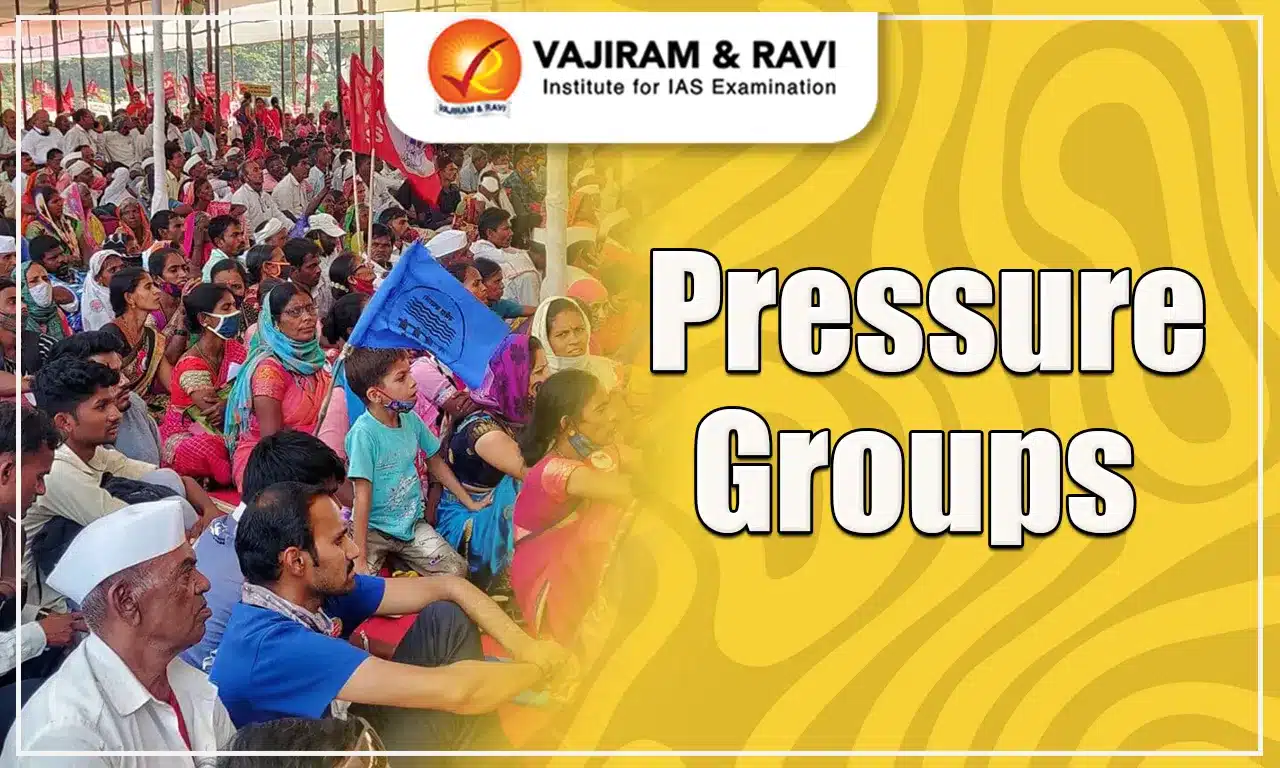Nuclear technology is the study of nuclear reactions involving atomic nuclei. Nuclear reactors, nuclear medicine, and nuclear weapons are all notable nuclear technologies. Nuclear power generates about 10% of global electricity, which is rising to nearly 20% in advanced economies. While it faces challenges in some countries, it has historically been one of the largest global contributors to carbon-free electricity and has significant potential to contribute to power sector decarbonisation.
Nuclear Energy
Nuclear energy is the energy released from the nucleus, or core of an atom, which is composed of protons and neutrons. Nuclear energy is produced in two ways: Nuclear Fission and Fusion.
Nuclear Fission
Nuclear Fission occurs when a neutron slams into a larger atom, forcing it to excite and split into two smaller atoms, also known as fission products. Further, this sets off a chain reaction when additional neutrons are released. Also, when an atom splits, it releases a tremendous amount of energy.
- Since Uranium and Plutonium are easy to initiate and control, they are the most commonly used as fission fuels in nuclear power reactors.
- The fission energy released in these reactors heats water into steam which generates carbon-free electricity by using steam to spin a turbine.
Nuclear Fusion
Nuclear fusion happens when two atoms collide to form a heavier atom, similar to how two hydrogen atoms fuse to form one helium atom. This is the same process that powers the sun and generates enormous amounts of energy—many times greater than fission.
Nuclear Reactor
Nuclear reactors are fundamentally large kettles that heat water to generate massive amounts of low-carbon electricity. They are available in a variety of sizes and shapes and can be powered by a variety of different fuels.
- A nuclear reactor generates and regulates the release of energy by splitting the atoms of specific elements.
- The energy released in a nuclear power reactor is used to generate steam, which is then used to generate electricity.
Components of Nuclear Reactor
- Fuel: The fuel used in a nuclear power plant contains fissile atoms whose energy is extracted by fission. Uranium-235 is the most common fuel.
- Control Rods: In a nuclear reactor, the chain reaction is constantly managed by means of control rods which are made from a material capable of absorbing neutrons. They can be dropped or pulled to maintain or increase the fission rate.
- Moderator: Its role is to slow down the neutrons released during the fission reaction which can otherwise be too energetic to efficiently provoke other fission reactions.
- Coolant: The heat released during fission must be transferred from the reactor core to the turbine and alternator. This role is guaranteed by the coolant, the fluid used to remove the heat generated by the nuclear fuel.
- Steam Generator:These are large heat exchangers for transferring heat from one fluid to another, here from a high-pressure primary circuit in PWR to a secondary circuit where water turns to steam.
Types of Nuclear Reactor
Since the inception of the nuclear power industry, several reactor technologies have been developed across the globe. These technologies differ by their choice of technological options.
Pressurized Heavy Water Reactor (PHWR)
PWHRs are the third most common reactor type, making up 11% of the global fleet.
- Development/Origin: The PHWR reactor has been developed in Canada as the CANDU since the 1950s, and in India, its development started in the 1980s.
- Fuel: Natural uranium (0.7% U-235) oxide.
- Moderator: Needs a more efficient moderator i.e., heavy water (D2O). Heavy water is used as a moderator because it slows down neutrons effectively and also has a low probability of absorption of neutrons.
- Coolant: Heavy water under pressure.
- It produces more energy per kilogram of mined uranium than other designs but also produces a much larger amount of used fuel per unit output.
Light Water Reactors (LWRs)
LWRs are power reactors that use ordinary water to cool and moderate them. The pressurized-water reactor (PWR) and the boiling-water reactor (BWR) are the two most common types.
- Pressurized water reactor (PWR): Pressurised water reactors (PWRs) make up almost 70% of the global reactor fleet.
- Development: It was developed in the Former USSR under the name of VVER.
- Fuel: Enriched uranium with 3% uranium-235
- Moderator: Ordinary water is used as both coolant and moderator.
- Boiling water reactor: They are the second most common reactor type globally, making up approximately 15% of the global fleet primarily found in the US, Japan, Sweden and Taiwan.
- Development: Technology developed in the US, Japan and Sweden.
- Fuel: Enriched uranium with 3% uranium-235
- Moderator and Coolant: Ordinary water boiling in the core.
- The reactor is designed to operate with 12-15% of the water in the top part of the core as steam, resulting in less moderating effect and thus higher efficiency.
Fast Reactors
Fast reactors are a versatile and adaptable technology that promises to generate or "breed" additional fuel by converting nuclear "waste" into "fissile" material.The term "fissile" refers to nuclear fuel, which is typically uranium or plutonium and can sustain a fission chain.
- Fast reactors use uranium-238 in addition to the fissile U-235 isotope used in most reactors.
- If fast reactors can produce more plutonium than the uranium and plutonium they consume, they are technically known as Fast Breeder Reactors.
- The fast reactor has no moderator and relies solely on fast neutrons to cause fission, which is less efficient for uranium than using slow neutrons.
- As a result, plutonium is commonly used as the basic fuel in fast reactors because it fissions sufficiently with fast neutrons to keep the reactor running.
International Regulatory Mechanism
There are several international regulatory mechanisms for nuclear technology to promote safe, secure, and peaceful use of the technology.
- International Atomic Energy Agency: The IAEA is the world's centre for cooperation in the nuclear field and seeks to promote the safe, secure, and peaceful use of nuclear technologies. It is widely known as the world’s “Atoms for Peace and Development” organization within the United Nations family.
- Non-Proliferation Treaty (NPT): The treaty on NPT was adopted in 1968 and entered into force in 1970. It has 191 member states and India is not a member.
- NPT is the centrepiece of global efforts to prevent the spread of nuclear weapons, to promote cooperation in the peaceful uses of nuclear energy, and to further the goal of nuclear disarmament and general and complete disarmament.
- Nuclear Non-proliferation & Disarmament: The international nuclear non-proliferation and disarmament regime focuses on nuclear weapons-related principles, norms, rules, and practices. The regime is historically based on the 1968 Treaty on the Non-Proliferation of Nuclear Weapons (NPT).
- Treaty on the Prohibition of Nuclear Weapons (TPNW): The TPNW was negotiated in 2017 and entered into force in January 2021. It seeks to strengthen the stigma associated with nuclear weapons in order to promote disarmament in accordance with the NPT's disarmament pillar.
- It imposes comprehensive restrictions on nuclear weapons, including their possession, use, and threat of use.
- Nuclear Suppliers Group (NSG): It was established in 1975.It is a group of nuclear supplier countries that seeks to contribute to nuclear weapon non-proliferation by implementing two sets of Guidelines for nuclear exports and nuclear-related exports.
- Members countries of the NSG have access to the latest technologies for a range of uses from medicine to building nuclear power plants.
- India is not a member of the NSG.
Applications of Nuclear Technology
In addition to producing electricity, nuclear technology has a variety of other beneficial applications. Agriculture, medicine, space exploration, and water desalination are among them.
- Agriculture: Agricultural workers use radiation to prevent harmful insects from reproducing.
- For example, Under SAMPADA (Scheme for Agro-Marine Processing and Development of Agro-Processing Clusters), the Ministry of Food Processing Industries provides subsidies to gamma radiation processing plants that are installed for gamma radiation processing of food products.
- Food: Irradiation kills bacteria and other potentially harmful organisms in food. This type of sterilization does not make the food radioactive or have a significant impact on its nutritional value. Irradiation is the only effective way to kill bacteria in raw and frozen foods.
- Medical: Nuclear technologies provide inside images of the human body and can aid in disease treatment.
- For example, Nuclear research has enabled doctors to precisely predict the amount of radiation required to kill cancer tumours while causing no harm to healthy cells.
- Space Exploration: Nuclear technology makes deep space exploration possible. Unmanned spacecraft generators use the heat from plutonium to generate electricity and can operate unattended for years. This dependable, long-term source of power propels these spacecraft even as they travel deep into space.
- For example: According to the Nuclear Energy Institute, Voyager 1, which was launched in 1977 to study the outer solar system, is still transmitting data today.
- Water Desalination: Water desalination is the process of removing salt from saltwater in order to make it drinkable. However, this process consumes a lot of energy. Nuclear energy facilities can provide the large amount of energy required by desalination plants to provide fresh drinking water.
Challenges of Nuclear Technology
Apart from significance, nuclear technology has some challenges which include:
- Large Operating Costs: With the strict maintenance regulations and, the need for staffing, training, and regular inspections, it is costly to compete in the nuclear energy market.
- Risk of Accident: Major nuclear incidents were caused by human error or natural disasters, which is unrealistic to manage or prevent, and nuclear energy is operated by humans.
- Nuclear waste: Radioactive nuclear waste, containing poisonous chemicals like plutonium and uranium pellets, requires meticulous and permanent disposal to prevent environmental pollution.
- Nuclear proliferation: There is widespread concern that the development of nuclear energy programs increases the likelihood of nuclear weapon proliferation. As nuclear fuel and technologies become more widely available, the risk of them falling into the wrong hands grows.
- Radiation exposure: Nuclear explosions produce radiation, and this radiation harms the cells of the body which can make humans sick or even cause them death. Illness can appear or strike people years after they are exposed to nuclear radiation.
Last updated on November, 2025
→ Check out the latest UPSC Syllabus 2026 here.
→ Join Vajiram & Ravi’s Interview Guidance Programme for expert help to crack your final UPSC stage.
→ UPSC Mains Result 2025 is now out.
→ UPSC Notification 2026 is scheduled to be released on January 14, 2026.
→ UPSC Calendar 2026 is released on 15th May, 2025.
→ The UPSC Vacancy 2025 were released 1129, out of which 979 were for UPSC CSE and remaining 150 are for UPSC IFoS.
→ UPSC Prelims 2026 will be conducted on 24th May, 2026 & UPSC Mains 2026 will be conducted on 21st August 2026.
→ The UPSC Selection Process is of 3 stages-Prelims, Mains and Interview.
→ UPSC Result 2024 is released with latest UPSC Marksheet 2024. Check Now!
→ UPSC Prelims Result 2025 is out now for the CSE held on 25 May 2025.
→ UPSC Toppers List 2024 is released now. Shakti Dubey is UPSC AIR 1 2024 Topper.
→ UPSC Prelims Question Paper 2025 and Unofficial Prelims Answer Key 2025 are available now.
→ UPSC Mains Question Paper 2025 is out for Essay, GS 1, 2, 3 & GS 4.
→ UPSC Mains Indian Language Question Paper 2025 is now out.
→ UPSC Mains Optional Question Paper 2025 is now out.
→ Also check Best IAS Coaching in Delhi
Nuclear Technology FAQs
Q1. What are the uses of nuclear technology?+
Q2. How does nuclear technology work?+
Q3. How is nuclear technology developed?+
Q4. What was nuclear technology first used for?+
Tags: nuclear technology quest






















